From Chronic to Episodic: An Illustrated Journey
A doctor once told me that migraines are like a river. She said my health is a bridge, and if the migraine river is overflowing, I won't be able to cross. Basically, when it rains it pours. Three years ago, I was drowning. My migraines became daily, severe, and uncontrolled.
My journey
I want to talk about how I became chronic and then episodic again. As Kerrie mentioned, we often don't hear these stories because the people who start to feel better no longer participate in the migraine community discussions. So in case it can give someone hope, I will share my story.
How did I become chronic?
The main factor I believe led my migraines to progress to chronic was the lack of diagnosis. Studies show that inadequate treatment of migraine can cause a greater risk of developing chronic migraine.1
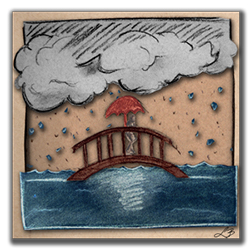 Central sensitization
Central sensitization
I was repeatedly undiagnosed and untreated despite complaints of very typical migraine symptoms such as throbbing head pain, fatigue, sensitivity to light and sound, and a stiff neck. Why did this matter? In my experience, migraines can build on each other, and each attack caused me to be more susceptible to the next attack as the patterns are reinforced in the brain.
This phenomenon is called central sensitization. When it rains it pours.
An unmanaged condition
This lack of awareness and understanding led to an unmanaged condition. Everyone gets headaches, right? I would think. Or, It’s just a headache. Because I didn't have anything to prevent or treat attacks, they repeatedly reinforced their pattern on my brain and worsened over time. I finally got a diagnosis three weeks before what I like to call "my migraine brain explosion into chronic craziness."
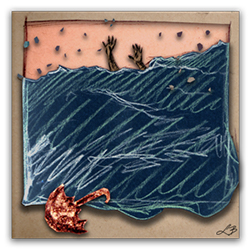
I felt hopeless
I faced some roadblocks, and it seemed hopeless. I had inadequate health insurance. I didn't know how to manage migraine. I had a small amount of Imitrex tablets, but that felt like fighting a tide with a chain-link fence.
How did I manage?
So what did I do to tackle this problem? I took a series of steps to slowly and surely start to lower the river's water levels. I had to reverse the process of central sensitization in my brain.
I knew I needed to learn more about migraine to fight the rising tides. I learned about migraines on the web, in books, and podcasts. I quickly learned basic concepts about migraine management and found a headache specialist who started me on a treatment plan.
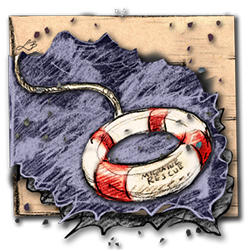 My treatment plan
My treatment plan
One part of my treatment that I feel was key for me was the use of triptans to aggressively treat every attack. This treatment is still controversial for chronic migraine patients because of the frequency of our attacks, putting us at risk for medication overuse headache. However, my doctor and I knew that my migraines were not a result of medication overuse as I had not been treating them with any medication prior to my recent diagnosis. The triptans helped keep some migraines at bay, so I believe my attacks had less chance to snowball.
I wasn't yet emptying water from the river, but I was learning to stay afloat during the waiting game of trying different preventive medications.
What did I try?
With my life preserver in place, I tried as much as I could. Different things work for different people, so much of migraine treatment is trial and error. It would take another article to list everything I've tried, but here are some key things that helped:
- Preventive medications: Gabapentin and Botox injections.
- Abortive, acute, and rescue medications: Imitrex injections, maxalt melts, zofran, and cambia.
- Rescue medications to avoid ER visits: Tramadol.
- Triggers: To help identify triggers: an elimination diet and migraine diary. To help avoid triggers: TheraSpecs glasses, ear plugs, lifestyle changes such as a regulated sleep schedule, work with a gynecologist on hormonal triggers, and much more.
- Diagnostic tests to rule out other conditions: A brain MRI, blood tests, and sleep study.
- Alternative medicine: Naturopathicdoctor, Ayurvedic doctor, 2 Chiropractors, 2 Physical Therapists, and mindfulness meditation.
- At home self-care: Ice packs, pain creams and patches, stretching/yoga, rest, hot showers.
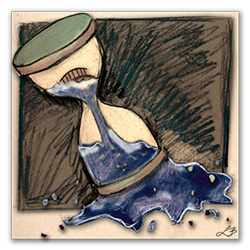 Reducing my migraine frequency
Reducing my migraine frequency
Not all the therapies worked, and some therapies made me feel sicker. Every day was a challenge. All I could do was keep persisting - email the doctor with new questions, ask about a new therapy or certain tests, and keep getting up again after I had been laid flat over and over. Sometimes it felt something was helping, and then I would have a setback. But slowly, the treatments that did help started to prevent or stop an attack. With fewer attacks, my brain had a chance to desensitize. I progressively needed stronger triggers to get an attack and was less sensitive to even my major triggers that would have guaranteed an attack before. The water levels were finally lowering.
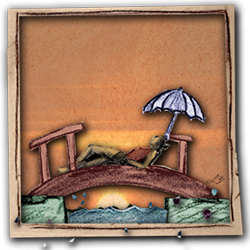 Becoming episodic
Becoming episodic
It took a good year or so to see meaningful improvement, and now three years later, my attacks are no longer chronic. As I am writing this, I recently had two migraine attacks. I can tell you the triggers for those attacks and that I treated both successfully before they interfered with my life. I know from having been chronic what a dream this new reality is. I also know I face a lifelong challenge to stay in balance constantly. The possibility of the resurgence of my illness always lurks in the back of my head. But for now, I am grateful for how far I've come and hope that sharing my story may help others.
Don't mind me while I take a nap on my bridge. I need a bit of a rest!
Community Poll
Do you feel comfortable advocating for yourself to your healthcare provider?
Join the conversation